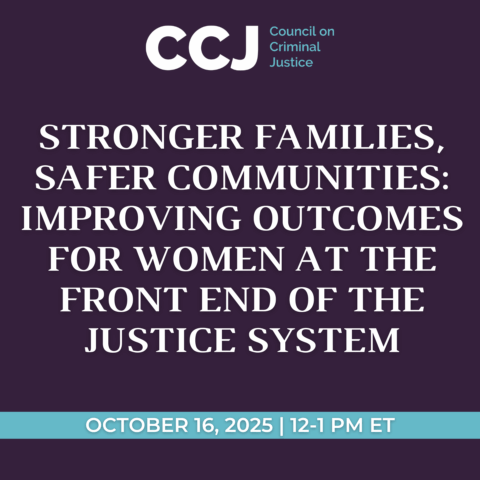As part of its government efficiency efforts, the White House is reviewing all surveys run by the U.S. Census Bureau. This includes the National Crime Victimization Survey (NCVS), which the Census administers in partnership with the Bureau of Justice Statistics.
NCVS is one of two primary sources of crime data in the United States. It’s an annual series of household interviews that captures offenses that are reported and not reported to the police. The other source, the Uniform Crime Reports, tracks crimes reported to law enforcement.
This week, the Council on Criminal Justice released a report exploring the strengths and limitations of these two measures of crime, the similarities and differences in long-term and short-term trends they document, and the importance of considering both sources when assessing changes in crime over time.
President Trump posted about NCVS findings during the 2024 presidential campaign and the Heritage Foundation’s Project 2025 included a passage about the survey, calling it “of particular importance” as “the only comprehensive and credible alternative to police reports for showing who commits crimes.” The report said the Justice Department “should prioritize and sufficiently fund it.”
Given the administration’s interest in the NCVS, to augment our new report we also surveyed several CCJ members and other experts to ask how NCVS adds to their knowledge about crime patterns and what changes could improve its value and cost-effectiveness.
Respondents included:
- Jeff Asher, Co-Founder, AH Datalytics
- Paul Cassell, Presidential Professor, S.J. Quinney College of Law, University of Utah
- Steve Derene, Co-Founder, National Association of VOCA Assistance Administrators
- Janet Lauritsen, Curators’ Distinguished Professor Emerita, University of Missouri-St. Louis and former president, American Society of Criminology
- John Malcolm, Vice President, Heritage Foundation
- Anne Seymour, Associate Academic Program Director, National Mass Violence Center
Their responses have been edited for length and clarity.
What value does the NCVS add to our knowledge about crime trends and patterns?
- Jeff Asher: NCVS is critical for a more complete understanding of the nation’s crime trends. Reported crime counts are extremely effective with respect to certain crime types such as murder. But they are less precise when it comes to other crimes that we know are systemically underreported, such as theft and sexual assault. NCVS fills that gap thereby providing a more confident assessment of crime in the United States each year.
- Paul Cassell: The NCVS is a critical tool for those concerned about crime victims, as it allows a reasonable assessment of crime victimization apart from official government reports. The NCVS traces back more than 50 years, and was considered an important part of making the criminal justice system more responsive to the needs and concerns of crime victims and their families.
- Janet Lauritsen: The NCVS is absolutely critical for understanding crime trends and patterns because most crimes in the United States are not reported to the police. For more than 50 years, the NCVS has provided continuous monitoring of the levels and changes in violent and property crimes, the population subgroups who experience victimization, when and where these events occur, and other details about the event that are not available in any other source of crime data. The NCVS also provides data on the physical and emotional consequences of victimization, the reasons for reporting or not reporting to the police, and other responses to such events such as the use of victim services. Without the NCVS, fundamental facts about the nature of crime that are used to inform policy decision-making would not exist.
- John Malcolm: The NCVS is a useful tool because it not only gives you trend information, but it is interesting to juxtapose that information with data provided to the FBI by local law enforcement authorities and prosecutors about crimes that were investigated and prosecuted (that database has problems in that a number of jurisdictions do not report that information). That differential can give you some idea about how effective and efficient law enforcement authorities are in addressing the crime problem and how confident people feel when it comes to reporting crimes that they witness or experience.
- Anne Seymour: The NCVS is a gold mine of data for the profession of victim/survivor services. I believe its greatest benefit is that it includes crimes not reported to law enforcement (versus the UCR) and, since we know that most/about half of crimes aren’t reported, these data are critical to our understanding of crime and victimization. In addition, it is super helpful and relevant to have details about the characteristics and demographics of victims and survivors. The data about victim/offender relationships are also important, and long-ago shed light on the “stranger-danger myth” of criminal victimization. Finally, it is helpful to have a reliable source of data going back over half a century so that comparisons across time and public policy developments can be made.
What changes could improve its value and cost-effectiveness?
- Cassell: The survey could be expanded to include additional crimes. In addition, the NCVS uses a large sample, which improves the validity of the conclusions. It would likely be possible to slightly downsize the sample size (by, let’s say, 10%) if financial circumstances make cuts necessary.
- Steve Derene: To the extent possible and practical, NCVS should try to evaluate the level of criminal activity experienced by those under the age of 12, even if based on responses by responsible adults or others who may have some valid measures.
- Lauritsen: The NCVS has undergone several major redesign efforts to improve the quality of its data and to enhance its value in measuring crime and informing practice. Most recently, new NCVS methods and questions were implemented beginning with surveys conducted in 2024. These changes will result in more information about persons’ views about the police and safety in their communities, as well as additional details about the victimizations that persons experience crime that are not found in any other crime data source.
- Seymour: My one wish for improvement is that it would be helpful to be able to suss out state and local crime and victimization data.
How can it be better used to inform policy?
- Cassell: Many decisions about the criminal justice system are made without considering the needs and concerns of crime victims and their families. The NCVS plays an important role in identifying victimization patterns and trends—particularly in areas where law enforcement reports are not fully capturing victimization issues.
- Derene: Since most criminal justice system responses are at the state and local levels, I believe that breaking out the data by relevant geographical localities (particularly state-level data) would make NCVS a much more practical tool for public policy decision-makers.
- Lauritsen: The NCVS data have been routinely used to provide the facts necessary for making decisions about crime policy. For example, Congress has mandated that the Bureau of Justice Statistics collect specific information about victimization using the NCVS and its supplements, including crimes such as family violence, crime in schools, hate-crimes, and fraud and internet crimes. Without the NCVS, the U.S. would lack reliable detailed information about the vast majority of such types of victimizations, and we would not know whether they were increasing or decreasing over time.
- Seymour: The NCVS is very helpful to victim services professionals in their public policy efforts, as it offers insights into increases and decreases in crime; who are the victims; and other data points that inform good public policy.




